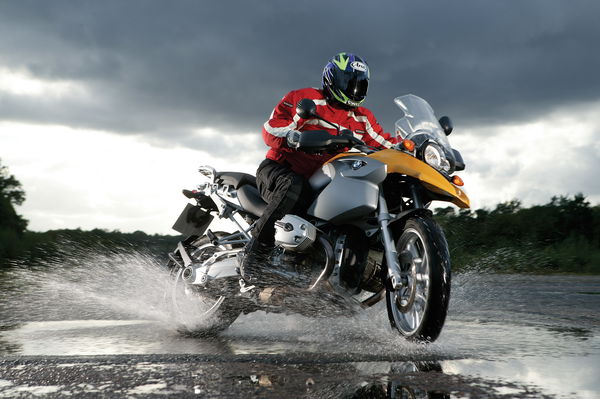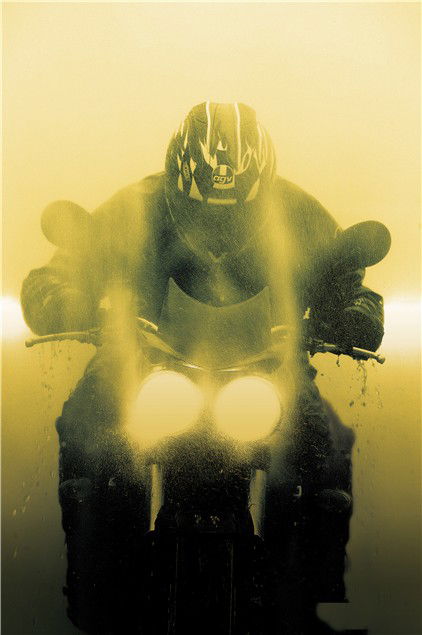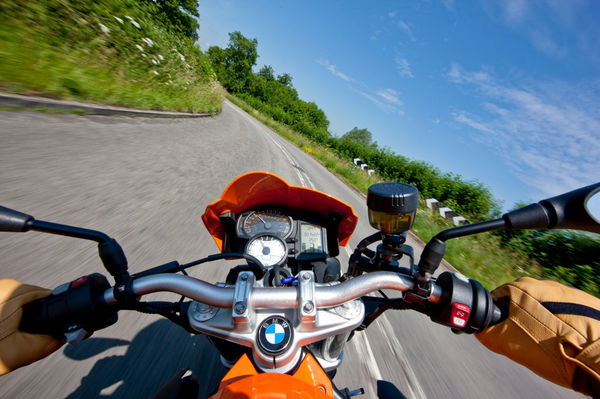Wet weather motorcycle riding tips
Nervous of riding in the rain? Don't be. The basics of riding well in the wet are the same as riding in the dry, you just need to think a little harder...

SOME PEOPLE ACTUALLY like riding in the rain. Really, they do. And there's a reason for it. The challenge of wet weather machine control can be as appealing as riding in the dry, perhaps more so. But for others, riding in the rain is such a fearful prospect that they simply don't bother.
That's the wrong approach. If you ride a bike in the UK you're going to get caught out more than once in a while, so developing wet riding skills should be high on your agenda. And there's no secret to it: the key to swift, safe riding in the wet is no different to that in the dry - you need to be smooth, relaxed and confident. Those three things are the building blocks of good riding no matter what the conditions. If you find it's necessary to make significant changes to your riding in the wet in order not to feel like you're constantly about to crash, there's probably something that needs addressing with your riding overall, not just when the heavens open. The trouble with modern suspension, brakes and tyres is that they are so good that many basic riding errors are masked or can be got away with in the dry. But once it's wet there's only so much a set of decent tyres can do, and heavy-handed steering inputs or clumsy throttle and brake control will manifest themselves as confidence-shattering twitches, slides or crashes.
So relax and be smooth - which is easier said than done if the thought of riding in the rain scares you rigid.
LOOSEN UP
The first thing to sort out is you: to ride smoothly, wet or dry, you need to be relaxed and supple on the bike, not rigid or tense. Sat in your normal riding position, let yourself almost slump down in the seat. Don't try and sit too upright, with your back straight or rigid.
Rest your hands on the bars without gripping them tightly, and making sure your elbows, shoulders and neck are loose and free to move. Also your hips need to be relaxed, and the balls of your feet on the pegs (except when rear-braking or changing gear) for better feel and control. This body-wide looseness is important in the dry but all the more so in the wet.
If the bike does slide or twitch, any movement of the machine is amplified if you're locked rigidly to it; by staying loose and flexible on the bike, most slides you experience will usually sort themselves out quickly and without drama. It's maybe easier said than done, but with time and wet weather experience your confidence should grow.
BRAKING
The best way to brake hard in the wet is the same as in the dry: squeeze, don't grab. Any sudden shock of force will break traction, but by easing progressively more force into the braking system it's possible to brake surprisingly hard in the wet.
Squeezing progressively doesn't have to mean squeezing slowly. With practice it's possible too apply smooth, progressive braking force quickly. The most important bit is the initial squeeze of the lever; too much too soon will have the brakes grabbing and locking the tyre before the forks have time to settle and transfer weight forward, where it can help generate grip.
And don't tense up. If your arms and shoulders are relaxed, and your hands not gripping the bars too tightly, you'll have a far better feel for front tyre grip.
In the dry, on a decent road surface with no bumps or cambers, it's possible to practice bringing a front tyre to the point of locking without risking a crash. In fact, it's surprisingly easy, but if you're going to try it make sure you're going in a dead straight line and there are no vehicles coming up behind you. It's best done carrying a bit of speed, too. The faster you're going, the more slowly things happen and the more inclined the bike is to want to keep going ahead if the wheel does lock, rather than fall over on its side.
In the dry, a front tyre just starting to lock-up will make a tearing sound; in the wet it's more of a 'whoosh' - unless the surface is polished smooth, in which case there's virtually no noise at all. Practicing rear brake skids is a handy skill to learn too, and again will give you more chance of dealing with a panic lock-up, wet or dry, should it occur.
Getting a feel for tyre grip in the dry will give you better feel for and advanced warning of an imminent lock-up in the wet. Be aware that the line between gripping and slipping is more sharply defined in the wet than it is in the dry, and if a wheel is going to lock you'll probably have less time to react, but some feel for the signs is better than none.
Ultimately you won't be braking quite as hard in the dry as you would in the wet, so with reduced forward weight transfer you might benefit from using more rear brake than you would in the dry. Practicing and getting a feel for rear wheel lock-ups is a useful exercise too (providing you don't have ABS or linked brakes), and once again will give you more of a chance of a dealing with a panic lock-up, wet or dry, should it occur.
TURNING
The mistake many people make in the wet is by riding too gingerly. By tip-toeing round corners on a closed throttle and as good as upright, generating virtually no cornering forces, your tyres will barely grip the road at all and the bike will feel unbalanced, nervous and twitchy. It's a downward spiral for nervous wet weather riders.
By riding confidently and smoothly, and actually generating some degree of braking and cornering forces, you make grip for yourself that otherwise won't be there. Sounds crazy? It works. Gently slide your finger across a smooth surface and it will glide across; push down with increasing force and it starts to grip. Of course there's a limit to this, but up to that limit you get more grip than you'd otherwise have.
If ever you're going to force yourself to relax, now is the time to do it. Once again, smoothness is the key. Any sudden load, be it from turning, braking or accelerating will shock a tyre into breaking traction, and turning in too suddenly, with too much turning force too soon, can have the front sliding. It may be no more than a nerve-wracking twitch or small slide, or it could have you on your ear. Instead, by squeezing the tyre into the road it will find grip.
That initial turn-in is perhaps the riskiest time in the wet, and to get the load off the front tyre you should be looking to get back on the throttle as soon as possible. We're not talking about accelerating out of the turn yet, rather using a neutral throttle (to maintain a constant speed) or gently positive one (very gradually building speed) to balance the bike and pull it through the turn. The other things you use to pull you smoothly through the turn are your eyes. Wet or dry, your eyes should be working together with the throttle to guide and drive you through every corner. Turn in, look through the corner to where you want to go and use the throttle to pull you to your exit.
Cornering on a closed throttle isn't the way to go wet or dry, and in the rain the bike will feel horribly nervous and unbalanced. Providing you slowed down enough before turning in, there should be no reason why you can't get back on the gas almost as soon as you're off the brakes.
ACCELERATING
Throttle control is the most important skill to master. Sorry if we're repeating ourselves here, but once again smoothness is the key. Any sudden application of force will break traction and the throttle is no exception. A big handful will get the rear spinning all too easily in the wet; progressively winding it on will give drive and traction.
What you want to be doing is matching engine rpm to throttle opening at all times. By that we mean you should be winding the throttle open progressively. If you stop opening it further you'll stop driving forward; roll it off and you lose drive instantly. Don't crack the throttle two-thirds open at low rpm in a high gear on the exit of a corner and wait for the engine revs to catch up. While many riders err to safety in the wet and go for the low revs/high gear option to avoid wheelspin, it's easy to get lazy with the throttle and open it wider than necessary.
Even at low rpm, many sportsbikes have enough torque to spin the wheel if the throttle is opened too far. If the wheel breaks traction, the engine is free to spin up to match the throttle position, which it will do very quickly indeed. If the throttle is open far enough, the engine will keep building revs even as you're rolling it off. At best you're risking a nasty, out-of-control fishtail, possibly into oncoming traffic; at worst, you're heading for a highside.
Once the bike is upright it's surprising just how much wet grip can be found on a good road surface. But while it used to be the case that once a bike was going in a straight line you could use as much throttle as you liked, many modern litre and hypersport bikes have more than enough power to spin up in the wet in the lower gears even when bolt upright. It's quite good practice to get the rear spinning up in the wet on straight roads, as it's good to get a feel for it in case the unexpected happens. But cambers and surface irregularities can have the rear wheel slewing sideways and out of control surprisingly quickly, so be careful.
SLIPPERY WHEN WET
No surprises here. White lines, cat's eyes, manhole covers, overbanding and metal marker studs are all best avoided in the wet. Diesel too, obviously, but for once the rain can help us out here since it's often more easily spotted in the wet; heavy spills will appear as an oily rainbow pattern on the road surface. Highly polished, sun-baked patches of tarmac can be hellishly slippery when wet too, even in a straight line when braking or accelerating, so be wary.
The age-old mantra of 'you go where you look' applies as much or more in the wet than at any other time. If you can see a smooth line avoiding slippery obstacles, visualise that line between them, follow it with your eyes and you should track safely through. If it's too late to avoid riding directly over something the two most important things to avoid doing are the two things many people find they do first: tense up and shut the throttle. Doing either - or both together - is more likely to have the front tyre sliding than anything else.
The key is not to panic. Stay relaxed, look over and beyond whatever it is you're about to hit and keep a neutral or gently positive throttle. If the throttle is open it's very hard to lose the front end in most situations, wet or dry. If your reactions are quick and smooth enough you can even roll the throttle off as the rear tyre crosses over the hazard beneath you, but don't worry if you can't time it right. If your vision is fixed well ahead and you're using a gently positive throttle opening, the back might spin momentarily but, providing you're crossing over nothing bigger than a manhole cover, it should grip and come back into line.
If you're on the brakes rather than driving forward when unavoidable slipperiness looms, releasing lever pressure as you pass over the hazard should be enough to avoid a lock-up. By looking well ahead and focusing on what's coming next, any slides or twitches tend to feel like they're happening behind rather than directly beneath you.
How tightly you're turning at the time also matters. In some cases it's preferable to pick the bike up a little in order to straight-line over whatever it is you're about to hit, but the danger is that panic-induced tension and target fixation to the outside of the corner will have you heading off in that (unwanted) direction.
The three keys to riding well in the wet, if you hadn't got the drift by now; relax, be smooth, and look well ahead. And enjoy it. You're riding your bike, aren't you?













